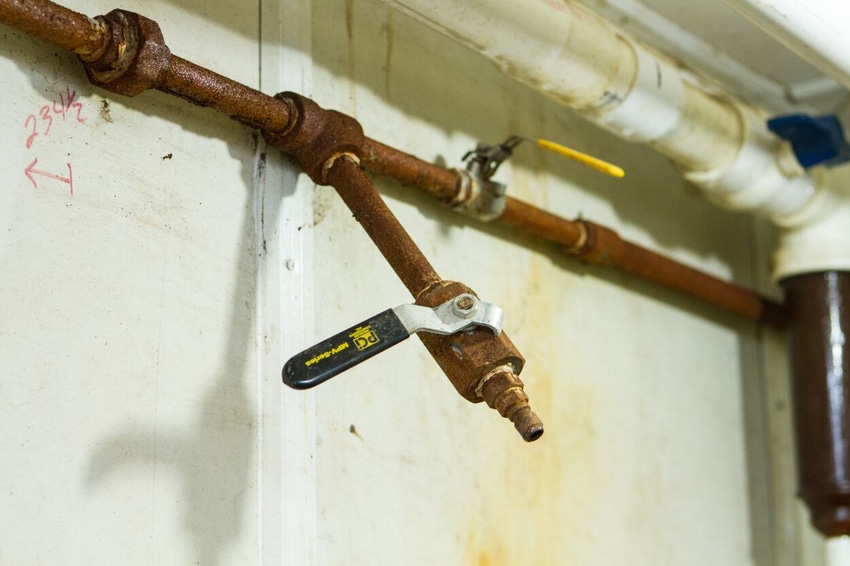Can PRRSV survive in tap water?
UMN research examines if pig exposure to contaminated water is possible with five different strains, three different temperatures.

Based on the Morrison Swine Health Monitoring Project data we know that the U.S. swine industry face an annual porcine reproductive and respiratory syndrome epidemic, with most outbreaks occurring during the fall-winter seasons. Recently, University of Minnesota researchers reported that about 40% of the MSHMP participating breeding herds report a PRRSV break within 15-30 days of manure pumping occurring.
“There's also been some results showing that about 10% of manure pits can contain PRRS virus genetic material, and the virus itself also has the ability to percolate,” says Valeria Lugo. “So, with this in mind, we asked the question of whether underground water can be contaminated and then be a source of transmission of the virus.”
While some studies have evaluated how long the PRRSV can survive in water, Lugo says it’s important to consider whether it can survive for long enough at a high enough concentration to be a considerable source of transmission. Most studies have evaluated a single strain, but at a lower temperature, where the virus might survive longer.
With this in mind, the research team aimed to compare the difference in survival times for five different strains of PRRSV at three different temperatures and four treatments. During the recent North American PRRS Symposium in Chicago, Lugo shared how the virus can remain viable in water for hours, days and even weeks.
Four strains of PRRSV-2 and one strain of PRRSV-1, representative of current co-circulating viruses, were grown in MARC-145 cells. Tap water from a laboratory faucet was collected in glass bottles and then separated according to chlorination, sterilization treatments or control: one was normal tap water, another one was sodium thiosulfate dechlorinated tap water, another one was autoclaved, and another one being both dechlorinated and autoclaved.
For sample preparation, the team did a 1:6 dilution, mixing 3.75 milliliters of water with 0.75 milliliters of the virus solution. For each termination of virus strain, water treatment and temperature, a triplicate was run.
Tap water was held at different temperatures: 37 degrees Celsius (37°C) when the tubes were kept inside an incubator; 21 to 23°C, or room temperature, when they were kept on a laboratory bench; and 4°C, when they were kept inside of the refrigerator. At each sampling point, the researchers collected 500 microliters of the sample, then homogenized, and immediately titrated. Three replicates were carried out for each combination of strain, temperature and water treatment.
The time to minimal detectable titer by the TCID50 microtitration assay for the different strains and water treatments ranged from six hours to 24 hours at 37°C, three to five days at room temperature, and 35 days at 4°C. For the L1C 144 variant in particular, the team saw that at 37°C, the time to minimal detection was 12 hours, for room temperature it was up to five days, and at 4°C, it took more than five days in regular tap water.
“If we were to compare this to the other strains, for 37°C, the times range from eight to 24 hours, for room temperature from three to seven days, and for 4°C more than 35 days,” Lugo says. “For all the strains, it seemed like the VR2332 strain was surviving the longest out of the other strains.”
Compared to the different water treatments, the results were very similar.
“Dechlorinated water, the ranges were also very similar. Once again, 37°C from eight to 24 hours, room temperature three to seven days, and 4°C at least 35 days” Lugo says. “When we autoclaved the water, once again, the results were very similar.”
There was a statistically significant effect of temperature on rate of reduction of viral titer over time; however, strain and water treatment were not found to be statistically significant. Post-hoc comparisons indicated that 37°C was significantly different than room temperature (21-23°C) and 4°C.
With the study showing the virus can remain viable in water for hours, days and up to weeks, and remaining stable for prolonged periods of time at 4°C, the researchers concluded there could be a significant risk for pigs being exposed to PRRSV contaminated water. Since there were limitations with the different starting titers and unmeasured chlorine levels for the water treatments, the team says further studies are needed to confirm the possible role water in PRRSV transmission.
“There was a marked effect of temperature on the virus by radius of time, with the longer viability at lower temperatures as expected. The virus viability was surprisingly not different between the types of water treatments that we tested. Strain VR2332 seemed to be the longest surviving strain of all the others even though it was not statistically proven,” Lugo says. “But with all of this, we found that PRRS remains stable for prolonged periods of time in water, which may raise questions regarding its potential role in transmission and dissemination.”
This study was funded by the University of Minnesota Swine Disease Eradication Center (SDEC).
About the Author(s)
You May Also Like





